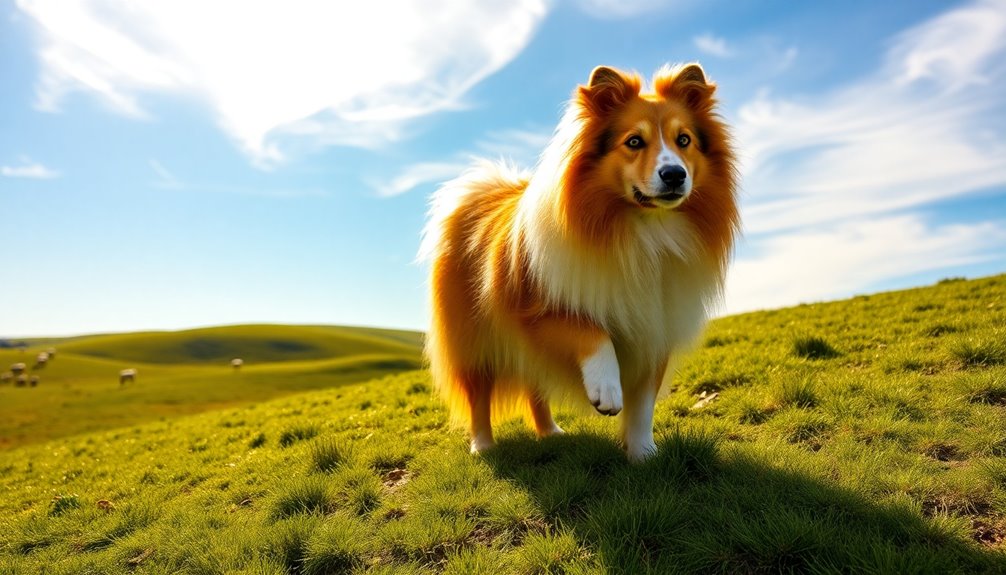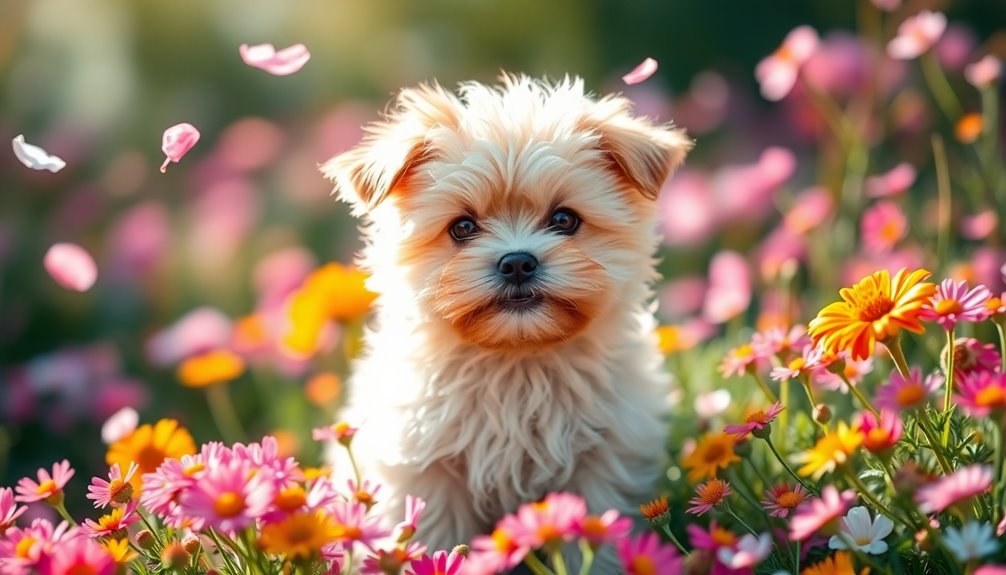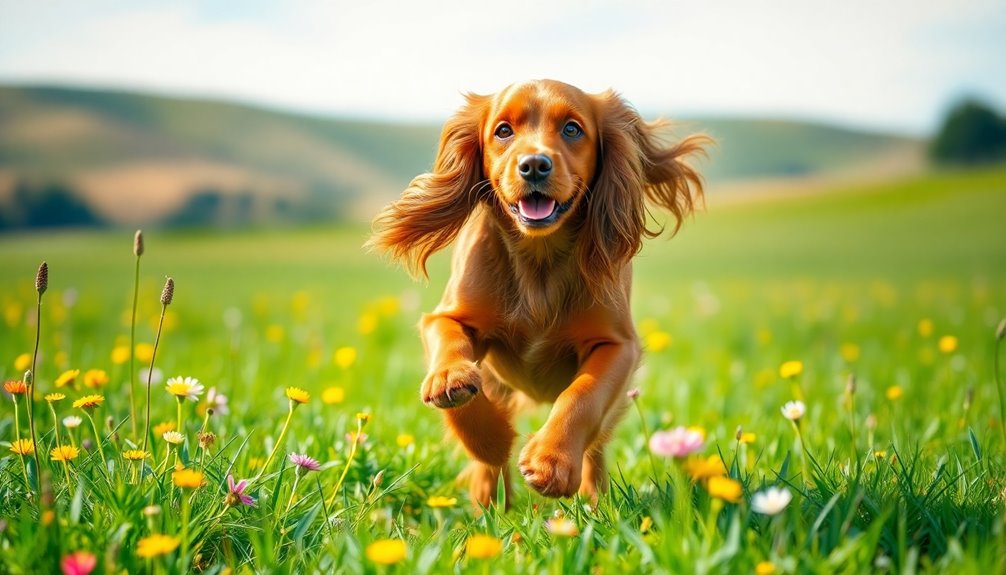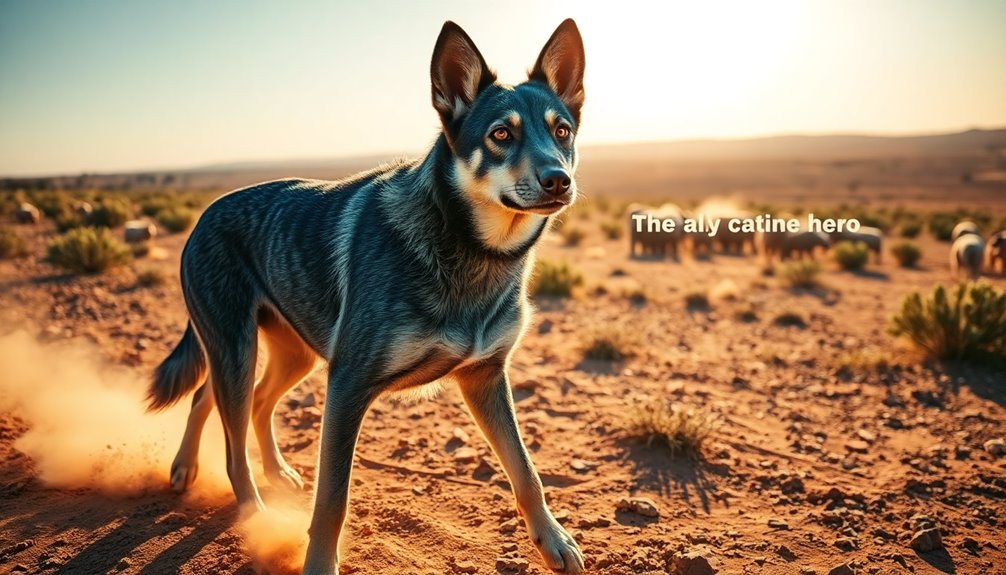The Shetland Sheepdog's a fantastic choice if you're looking for an intelligent and agile companion. These dogs stand between 13 to 16 inches tall and weigh 15 to 25 pounds. With their loyal and affectionate nature, they excel in family settings, especially with kids and other pets when socialized properly. They're highly trainable and respond well to positive reinforcement, making them an ideal candidate for agility training and obedience. Daily exercise and mental stimulation are crucial to keep your Sheltie happy and healthy. Stick with us to discover more about their care and unique traits.
Key Takeaways
- Shetland Sheepdogs are intelligent, ranking 6th among dog breeds, making them easy to train and responsive to positive reinforcement.
- Their agility and herding instincts make them excellent companions for active families, requiring daily exercise of 30 to 60 minutes.
- With a loyal and affectionate temperament, Shelties are rated highly for compatibility with children and can get along well with other pets.
- They have a thick, weather-resistant double coat that requires regular grooming to manage shedding and maintain coat health.
- Originating from the Shetland Isles, these dogs were bred for herding and guarding livestock, showcasing their versatility and work ethic.
Introduction
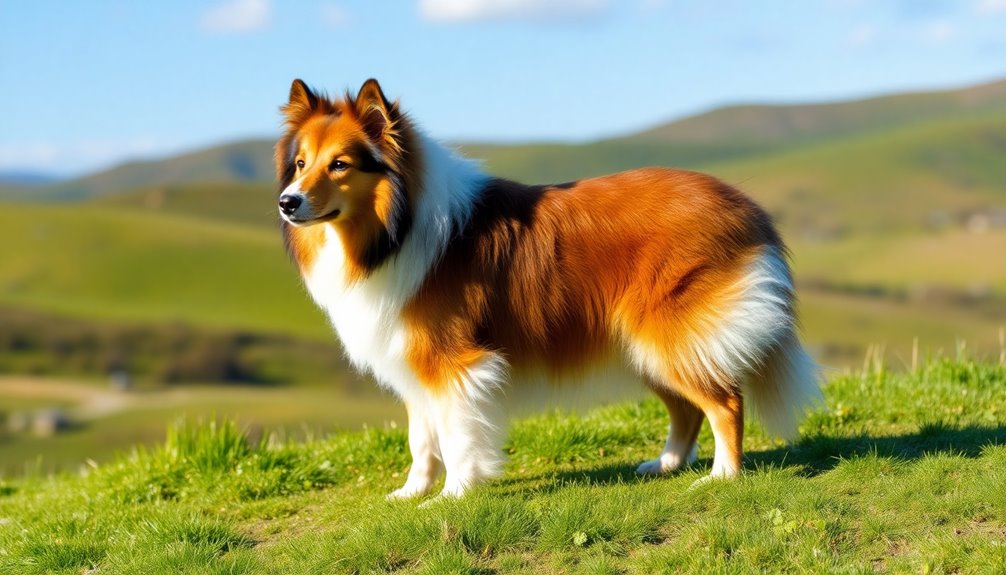
When you think of a herding dog that's not just intelligent but also incredibly loyal, the Shetland Sheepdog often comes to mind. Standing between 13 to 16 inches tall and weighing 15 to 25 pounds, these dogs are compact yet sturdy. Their long, straight, thick double coat comes in various striking colors, including sable, blue merle, and combinations of black with white and tan.
Shetland Sheepdogs are highly intelligent, ranking sixth in intelligence among all breeds, which makes them easy to train. They thrive on daily exercise, needing 20 to 40 minutes of physical activity to keep their energy levels in check. They require 1 to 2 hours of daily exercise to maintain their physical health and well-being.
Their affectionate nature and strong loyalty make them loving companions, though they can be wary of strangers. Playfulness is a hallmark of their behavior, and they enjoy engaging in activities with their families.
However, be prepared for some barking, as they tend to alert you to anything unusual. With moderate social needs, they require companionship and mental stimulation to stay happy. Keep in mind that they can experience separation anxiety, so it's essential to provide them with reassurance and love.
History and Origin
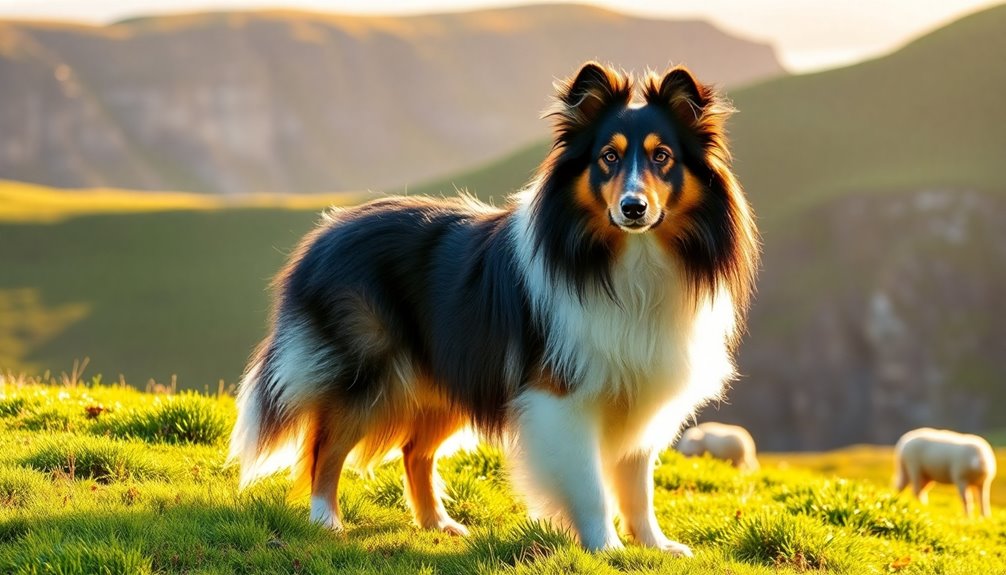
The Shetland Sheepdog originated in the remote Shetland Isles off the coast of Scotland around the 1840s. These islands, with their harsh climate, played a crucial role in shaping the breed, as they were developed to guard and herd livestock. You'll find that the unique geographic conditions and the isolation of the islands significantly influenced the Sheltie's characteristics and abilities. The breed was initially created as a companion and herding dog to assist with livestock management while also providing companionship to the families in the region.
Where and when the breed originated
Shetland Sheepdogs, often affectionately called Shelties, trace their origins back to the rugged Shetland Islands off the coast of Scotland.
In the 1700s, Scottish farmers imported Scandinavian herding dogs, likely Spitz breeds, to assist with livestock management. Over time, these dogs were crossbred with mainland working breeds like the Greenland Yakki, Rough Collie, and Border Collie, creating the foundation for what you know as the Sheltie today. The breed's development was also influenced by smaller pet breeds, including the King Charles Spaniel and Pomeranian, which helped miniaturize the dogs.
The harsh climate and challenging terrain of the Shetland Islands honed the breed's skills as efficient herders, with early Shelties, known as Toonies, playing a vital role in the island economy. The breed's recognition by the UK Kennel Club in 1914 marked a significant milestone in its breed development, establishing formal standards for its appearance and temperament.
Documentation of the breed dates back to 1840, featuring an engraving of a Sheltie in Lerwick, the capital of Shetland.
Farm Livestock Guardian
Originating from a lineage of herding dogs, Shetland Sheepdogs were also valued as livestock guardians on the rugged Shetland Islands. These intelligent, agile dogs assisted farmers by herding sheep and protecting them from predators in a challenging landscape. Their protective instincts were cultivated in the harsh environment, making them adept at guarding livestock. To enhance their guarding capabilities, Shetland Sheepdogs were crossed with breeds like the Border Collie and the Greenland Yakki. This selective breeding improved their traits, ensuring they were well-equipped for the demanding roles of herding and guarding. Their limited gene pool on the islands helped solidify their unique characteristics. While they're loyal and alert, Shetland Sheepdogs differ from traditional livestock guardian dogs. They were primarily bred for herding, not exclusively for guarding. Their size and agility make them effective in confined spaces, enabling them to navigate rugged terrain. Livestock guardian dogs serve a vital role in protecting flocks from predators, which aligns with the Shetland Sheepdogs' historical use as guardians. Although they're more often kept as family companions today, their history as livestock guardians remains an integral part of their identity. With their keen instincts and trainable nature, they continue to be a valuable addition to farm life.
Physical Characteristics
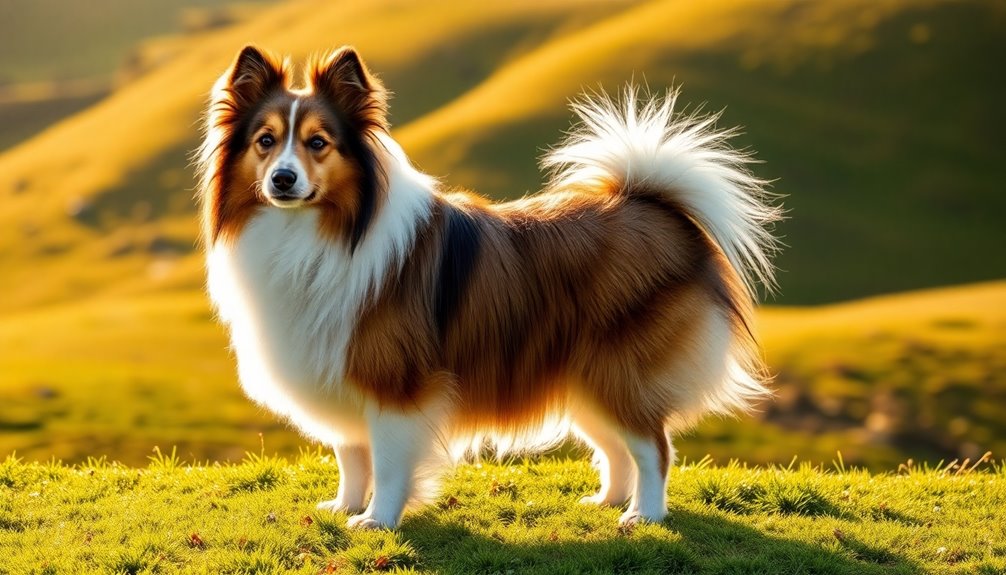
When you think of a Shetland Sheepdog, picture a compact yet sturdy dog that stands about 14 to 14.5 inches tall and weighs between 14 and 20 pounds.
Their long, double-coated fur can come in various colors, and you'll notice their feathered legs and tail adding to their elegance. This breed's double coat not only provides insulation but also protects them from harsh weather conditions on the Shetland Islands.
These physical traits not only enhance their beauty but also reflect their herding heritage.
Size, weight, and coat details
With a height range of 13 to 16 inches and a weight typically between 11 and 27 pounds, Shetland Sheepdogs present a compact yet sturdy frame.
You'll find significant size variations even within the same litter, with some dogs measuring as short as 8 inches or as tall as 19 inches. For those in the lower height range (13-14.5 inches), weights usually fall between 12 and 17 pounds, while dogs in the higher range (15-16 inches) typically weigh 18 to 25 pounds.
Shetland Sheepdogs boast a thick, weather-resistant double coat. The outer coat is long, harsh, and straight, while the undercoat is soft, short, and dense, standing away from the body. Weight variations exist due to bone structure; healthy shelties can be observed from 8 to 35 pounds.
Males often have a more profuse coat than females. Coat colors vary, including black with white and/or tan, blue merle with white and/or tan, and sable with white and/or tan.
Be aware that these beautiful coats require regular grooming, especially during shedding seasons in the fall and spring. You'll need to brush them at least twice a week to keep their fur healthy and tangle-free.
Feathered Legs and Tail
Shetland Sheepdogs are known for their striking feathered legs and tails, which contribute significantly to their overall appearance. The front legs feature short, smooth hair on the front, while the back is well-feathered. The hind legs are heavily feathered down to the hock, with smooth hair below the hock joint. This feathering is an essential aspect of the breed's characteristic look, requiring regular grooming to prevent matting.
You'll notice that males generally have more profuse feathering than females.
The tail is another defining feature, set low and forming a natural extension of the topline. It starts thicker at the base and tapers to the tip, extending at least to the hock. When relaxed, the tail hangs down naturally or curves slightly upward, while it may be raised when alert, though never higher than the back. This breed's weather-resistant coat not only protects them from harsh climates but also adds to their overall beauty.
The tail is richly plumed, and excess hair can be trimmed for show purposes. Proper tail carriage enhances the dog's posture and expression, while incorrect carriage can impact both appearance and movement. This feathering and tail movement reflect the breed's energetic and alert demeanor.
Temperament and Personality
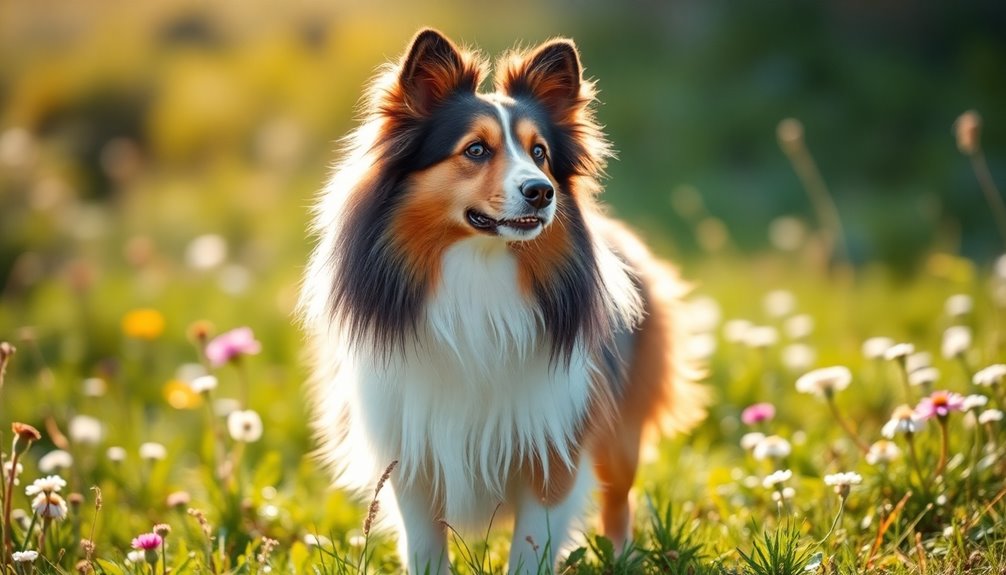
When you think about a Shetland Sheepdog's temperament, you'll find they're playful and eager to please, making them a fantastic choice for families or individuals. Their gentle nature and compatibility with other pets create a harmonious home environment. Plus, their affectionate personality ensures they'll quickly become a beloved member of your household. These dogs are known for their high energy, requiring regular exercise and mental stimulation to thrive.
Playful and Eager to Please
One of the most charming aspects of the Shetland Sheepdog is its playful and eager-to-please nature. This breed thrives on interaction and attention, making them an affectionate companion. You'll find that their loyalty is unwavering; they form deep bonds with you and enjoy participating in daily family activities.
Their sensitive demeanor allows them to pick up on your mood, creating a strong emotional connection.
Shetland Sheepdogs are highly intelligent and learn quickly, responding exceptionally well to positive reinforcement like treats and praise. Whether it's agility courses or obedience training, their eagerness to please makes them wonderfully trainable. Additionally, their strong work ethic translates into a dedication to tasks, further enhancing their trainability.
However, they require a calm and kind leader to guide them effectively.
Being energetic and active, Shelties need regular exercise and mental stimulation to keep boredom at bay. Daily walks, playful runs, or engaging in puzzle toys are essential to their well-being.
If left unchallenged, they may develop destructive behaviors. Overall, their playful spirit and desire to make you happy ensure that your time together is filled with joy and companionship.
Suitability for families, individuals, or other pets
With their loyal and affectionate nature, Shetland Sheepdogs make excellent companions for families, individuals, and even other pets. They're particularly kid-friendly, scoring a perfect five out of five in the AKC's breed rating, and they form deep bonds with family members. Their protective instincts mean they'll watch over your children without being aggressive, creating a safe environment.
For individuals, Shelties thrive when given regular exercise and mental stimulation. They're intelligent and trainable, but they require consistent interaction to prevent stress-related behaviors. Daily grooming is also essential to maintain their coat health and manage shedding. If your home is calm and engaging, a Shetland Sheepdog will flourish.
When it comes to other pets, Shelties generally get along well with dogs, especially if they're properly socialized. However, they may show herding tendencies, so managing that behavior is essential. With cats, they can coexist peacefully if introduced gradually and given separate spaces.
Health and Lifespan
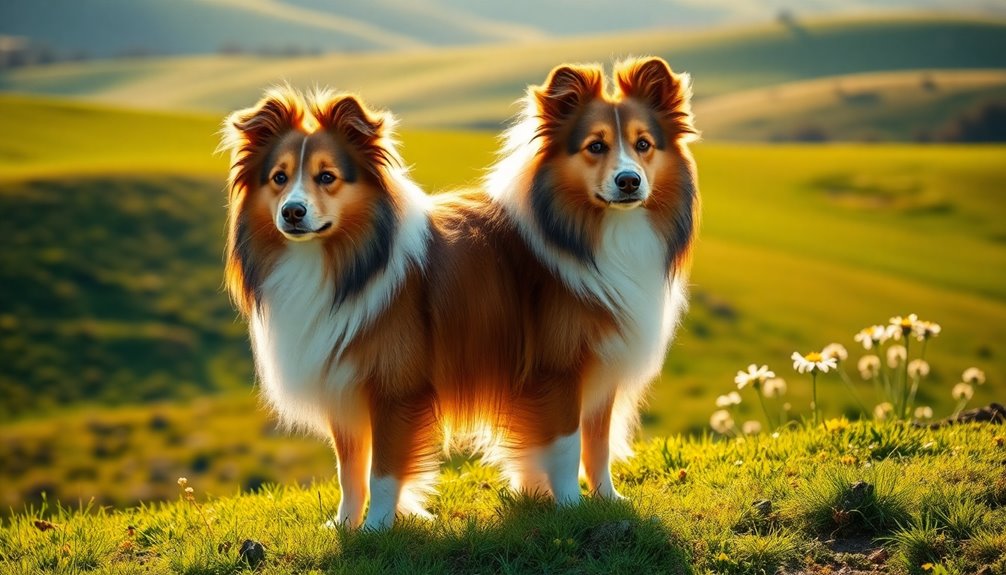
When it comes to the health and lifespan of Shetland Sheepdogs, you'll find they typically live between 12 to 14 years, with some reaching 16 or more with proper care.
However, be aware of common health concerns like dental disease, bone issues, and heart problems that can affect their quality of life. Responsible breeding can help minimize genetic health issues that may arise in this breed.
To help your Sheltie thrive, focus on a balanced diet, regular exercise, and routine veterinary check-ups.
Typical lifespan of the breed
Understanding the typical lifespan of a Shetland Sheepdog can help you provide the best care for your furry companion. On average, Shelties live between 12 to 14 years, but with proper care and attention, some can reach up to 16 years. Generally, smaller breeds like the Shetland Sheepdog tend to enjoy a longer life expectancy compared to larger dogs.
Several factors influence your Sheltie's lifespan. Genetics play a role, as certain hereditary conditions can affect health and longevity. A balanced diet is crucial; it helps prevent obesity and related health issues. Additionally, regular veterinary check-ups are essential for early detection and management of health conditions.
Regular exercise supports joint health, cardiovascular fitness, and mental stimulation, all of which contribute to a longer life. Routine veterinary care is essential as well. Regular check-ups and preventive measures, such as vaccinations and health screenings, can help catch potential issues early.
As your Sheltie matures through puppyhood, adolescence, and adulthood, tailoring their care to their life stage is vital. By focusing on optimal nutrition, consistent exercise, and preventive care, you can help your beloved Shetland Sheepdog enjoy a happy and healthy life.
Common health concerns or genetic predispositions
As your Shetland Sheepdog ages, being aware of common health concerns and genetic predispositions is crucial for maintaining their well-being. One significant issue is heart-related conditions, such as Patent Ductus Arteriosus, which can cause fluid buildup in the lungs. Obesity can also lead to heart diseases, so keeping an eye on their weight is essential.
Eye problems are another concern, with Collie Eye Anomaly affecting over 48% of the breed. This can lead to serious conditions like cataracts, which may require surgery. Additionally, Progressive Retinal Atrophy could impair their vision over time.
Digestive issues like gallbladder disease and pancreatitis are common, often linked to obesity and hyperlipidemia. It's vital to monitor their diet and ensure they maintain a healthy weight. Furthermore, Shetland Sheepdogs have a high-quality diet that is recommended to prevent obesity-related complications.
Lastly, watch for skin and neurological conditions, such as Atopy and Epilepsy, which can impact their quality of life. Being proactive about these health concerns will help you provide the best care for your Shetland Sheepdog as they grow older.
Regular vet check-ups are essential for early detection and management of these potential issues.
Tips for maintaining health and wellness
Maintaining your Shetland Sheepdog's health and wellness is essential for a long and happy life. Start by providing high-quality dog food that meets their nutritional needs, including the right balance of proteins, carbohydrates, fats, vitamins, and minerals. Make sure to choose a diet appropriate for their age and size, and avoid feeding them people food to maintain consistency. Keep an eye on their weight to prevent obesity.
Regular exercise is crucial for both their physical and mental well-being. Aim for daily walks, play fetch, and consider agility training to help channel their energy positively. Just be cautious not to overexert them, particularly in extreme weather. Shetland Sheepdogs are highly adaptable and thrive in various living environments with sufficient stimulation.
Grooming is another important aspect. Brush their coat at least weekly, paying special attention behind the ears to prevent mats and tangles. Don't forget dental care; brushing their teeth three times a week is ideal. Regular grooming can also help you catch potential health issues early.
Finally, ensure you keep up with regular veterinary check-ups. Stay on top of vaccinations, parasite preventatives, and routine examinations to help detect any health concerns before they escalate.
Care Requirements
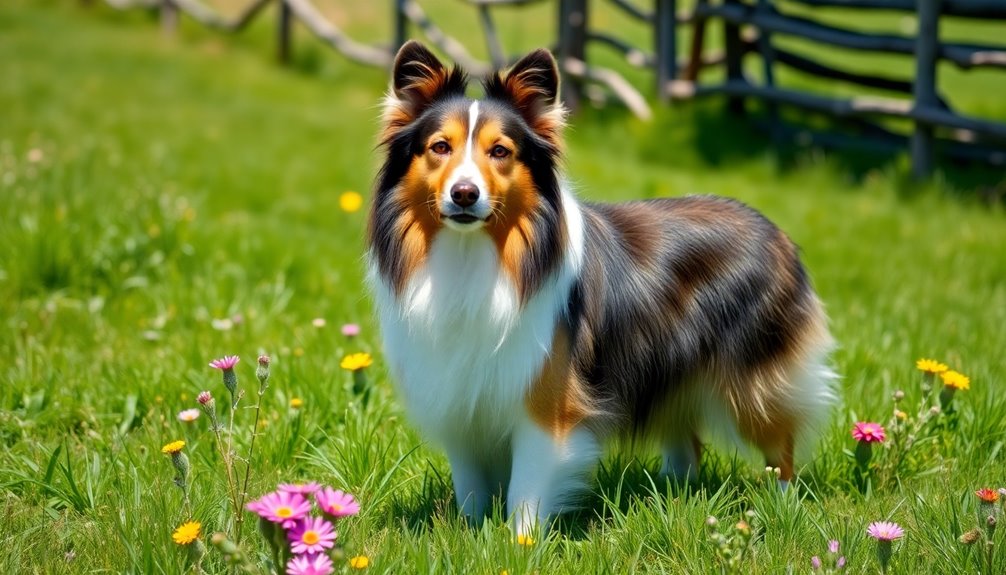
Caring for your Shetland Sheepdog involves regular brushing to keep their coat healthy and mat-free. You'll also need to ensure they get enough exercise each day to match their energy levels, along with a balanced diet tailored to their needs. Additionally, it's important to provide them with approximately 1 hour of exercise daily to keep them physically and mentally stimulated.
Regular Brushing Required
Regular brushing is essential for keeping your Shetland Sheepdog's coat healthy and free from mats and tangles. Aim to brush at least 2-3 times a week. During shedding seasons, daily brushing is a must to manage the heavy fur loss.
Regular brushing not only prevents matting but also allows you to check for any potential health issues early on.
Use a slicker brush for the outer coat to clear away tangles and loose hair. An undercoat rake or wide detangling comb works wonders on the dense undercoat. For precision, a fine-toothed comb is perfect for sensitive areas.
Don't forget to focus on spots like behind the ears, under the armpits, and the back thighs, which are prone to matting. The tail also needs attention to keep it feathered and neat.
Consider using a detangling spray to ease the grooming process. Bathing your dog every 1-2 months will help maintain the coat's natural oils. Additionally, regular grooming can help manage the undercoat effectively, which is crucial for Shelties.
Exercise requirements and energy levels
A Shetland Sheepdog thrives on daily exercise, needing 30 to 60 minutes to stay happy and healthy. You can split this time into two or three sessions, incorporating structured walks and interactive play. Activities like fetch, tug-of-war, and agility training not only provide physical fitness but also satisfy their herding instincts.
Adjust the intensity of the exercise based on your dog's age and health. Puppies require gentle activities to support their growth, while adult Shelties can handle more vigorous routines. Senior dogs benefit from low-impact exercises, such as leisurely walks or swimming, to minimize joint stress. Health-centric exercise approaches ensure that exercise plans align with individual health needs.
Keep your dog's health in mind, and schedule regular veterinary check-ups to tailor exercise plans accordingly. Variety is essential to prevent boredom. Mix up activities with obedience training, puzzle toys, and socialization through playdates or trips to dog parks.
Establishing a consistent routine creates structure and discipline, while off-leash time in secure areas allows for freedom. By tailoring activities to your Sheltie's energy levels and preferences, you can ensure they remain physically fit and mentally stimulated. Engaging regularly will keep your Shetland Sheepdog happy and healthy.
Feeding tips and diet recommendations
Providing your Shetland Sheepdog with a balanced diet is essential for their overall health and well-being. Focus on high-quality protein sources like chicken, beef, lamb, and fish, which support muscle development and repair. Incorporate healthy fats, particularly omega-3 and omega-6 fatty acids, to enhance energy levels and coat health. Balanced carbohydrates from whole grains, vegetables, and fruits provide necessary fiber for digestion. Ensure real meat is the first ingredient in their food, steering clear of fillers and artificial additives. A balanced diet should meet the specific needs of their life stage—puppy, adult, or senior.
Puppies typically need three to four meals daily, while adults thrive on two meals. Control portions to prevent overfeeding; aim for 3/4 to 1.5 cups of dry food daily for adults. Keep fresh water available at all times, as hydration is crucial. Use treats sparingly, mainly for training rewards.
If your dog has special dietary needs or health issues, consult your vet to tailor their diet appropriately. Regular check-ups will help you adjust their nutritional intake based on their health and activity levels.
Training and Socialization
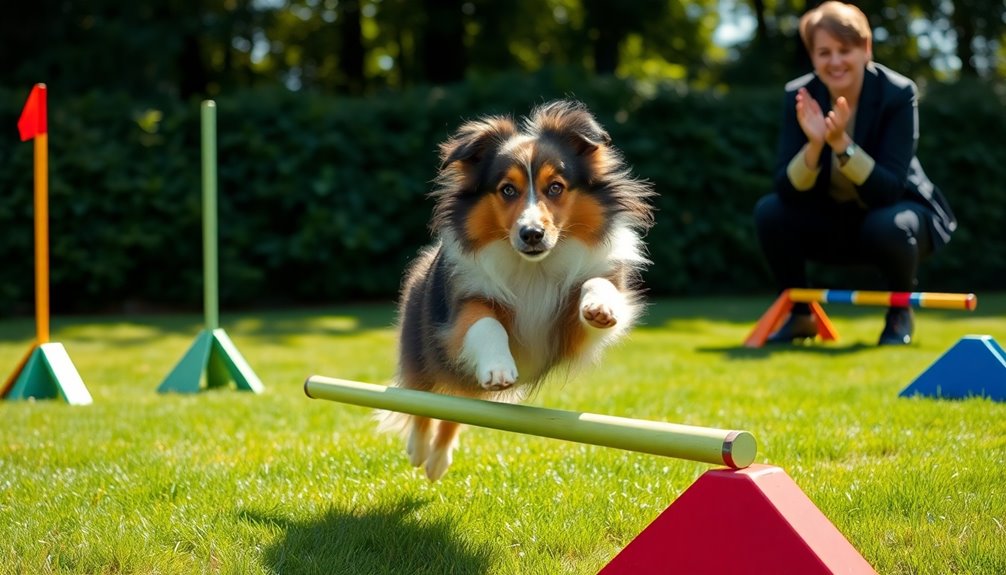
Training your Shetland Sheepdog can be a rewarding experience, especially since they're highly trainable with the right consistency. Start by gradually introducing them to new environments to help them adjust and prevent separation anxiety. Incorporating positive reinforcement in your training sessions will enhance their learning and build a strong bond between you and your dog.
Highly Trainable With Consistency
How can you unlock the full potential of a Shetland Sheepdog? By embracing their high intelligence and strong desire to please, you'll discover just how trainable they are. Ranked among the top 10 most intelligent breeds, Shelties quickly learn new tricks and tasks, making training sessions an exciting challenge for both of you. Their natural herding instincts drive them to be active and engaged, so incorporating training into daily activities is essential.
Consistency is vital. Establish a clear routine and structured training schedule to help your Sheltie develop good habits without confusion. Additionally, their strong work ethic ensures they remain motivated and ready to participate in training sessions.
Use positive reinforcement techniques—treats, praise, and affection—when they exhibit desired behaviors. This not only motivates them but reinforces the idea that good behavior leads to positive outcomes.
Gradual Introductions to New Environments
Introducing your Shetland Sheepdog to new environments is crucial for their development and comfort. Start by gradually introducing them to new dogs and other animals. Keep resident pets in another room initially, allowing your new dog to explore their surroundings without stress. Supervise interactions closely for the first two weeks, rewarding calm behavior with treats and praise.
Expose your Shetland Sheepdog to various environments, like parks, pet stores, and cafes. Take them on walks over different surfaces such as grass, sand, and concrete to enhance their comfort. Include car rides in your routine to help them adjust to new situations. It's also important to allow time for shy or submissive behavior, helping them regain trust gradually.
Introduce your dog to different people in a calm and controlled manner. Encourage interactions with individuals of various ages and backgrounds, inviting them to offer treats and gentle petting. Begin with easier social scenarios and gradually increase the challenge as your dog gains confidence.
Always use positive reinforcement, rewarding desired behaviors with treats and affection. Be patient and consistent, as every dog adjusts at their own pace. A gradual approach will help your Shetland Sheepdog thrive in new environments, ensuring they remain a happy, well-adjusted companion.
Separation Anxiety in New Settings
Separation anxiety can be a distressing experience for both you and your Shetland Sheepdog in new settings. You might notice signs like excessive barking, pacing, or even destructive behavior when you leave. These reactions can stem from genetic predisposition, lack of training, or changes in your routine.
To help your Shetland Sheepdog adjust, start by establishing a consistent departure routine. This signals that you'll return, easing their anxiety. Gradually increase the time you spend away, allowing them to adjust to your absence. Leaving background noise, like a TV or radio, can also provide comfort and distraction.
Socialization is key—introduce your dog to various environments and people to lessen their dependence on you. Use desensitization techniques to make them less sensitive to your leaving cues. Encourage independent play and consider engaging them with interactive toys filled with treats.
If anxiety persists, think about enrolling your dog in daycare or hiring a dog walker. By implementing these strategies, you can help your Shetland Sheepdog feel more secure and comfortable in new settings, reducing their separation anxiety.
Ideal Living Environment
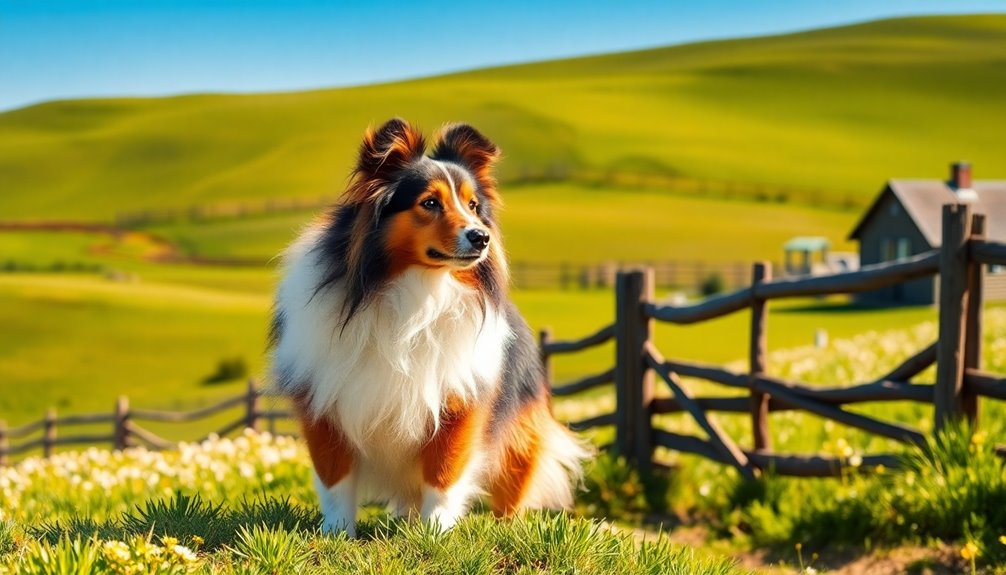
If you're considering bringing a Shetland Sheepdog into your home, it's essential to have ample outdoor space for them to run and play.
These dogs thrive in cooler, temperate climates, so keep that in mind when choosing your living environment.
Providing a suitable space not only supports their physical health but also enhances their overall happiness.
House With Ample Outdoor Space
Having ample outdoor space is essential for a Shetland Sheepdog to thrive. These intelligent and agile dogs require at least 1-2 hours of exercise and playtime daily. A spacious yard is crucial for running, playing, and engaging in herding activities. Indoors, your home should allow for active movement, ensuring your Sheltie can stay fit and happy.
Opt for a yard with a mix of grass, dirt, and possibly wooded areas. This varied terrain not only provides exercise but also accommodates their natural digging habits. Make sure surfaces are easy on their joints; grass or wood chips work well.
It's also vital to secure your yard with a sturdy fence, preventing escapes and protecting against predators. Check that there are no gaps where your pup could squeeze through.
For mental stimulation, consider having other pets around, outdoor toys, and opportunities for herding simulations. Regular changes in the environment help keep boredom at bay.
Lastly, ensure your Sheltie has access to shaded areas to stay cool during playtime. A well-designed outdoor space will enhance your Shetland Sheepdog's quality of life and strengthen your bond.
Prefers Cooler, Temperate Climates
Shetland Sheepdogs flourish in cooler, temperate climates, where their thick double coat can protect them from the elements.
These dogs thrive in temperatures between 40°F and 70°F (4°C and 21°C), making them sensitive to extreme heat and high humidity. You'll find they handle cold climates better than hot ones, so it's wise to avoid areas with scorching summers or significant temperature fluctuations.
The Shetland Sheepdog's origins in the cool Shetland Islands explain their preference for regions with mild winters and cool summers. Ideal locations include coastal or mountainous areas with frequent breezes or sea air.
When exercising your Sheltie, schedule walks and playtime during the cooler parts of the day to prevent overheating. Mental stimulation is also crucial; consider agility and obedience training to keep them engaged.
Be mindful of heatstroke risks in warmer climates. Regular veterinary check-ups can help monitor their health, especially in extreme weather.
Always ensure they've access to shade and fresh water. By recognizing their climate preferences, you'll keep your Shetland Sheepdog happy and healthy.
Shetland Sheepdogs Excel in Agility
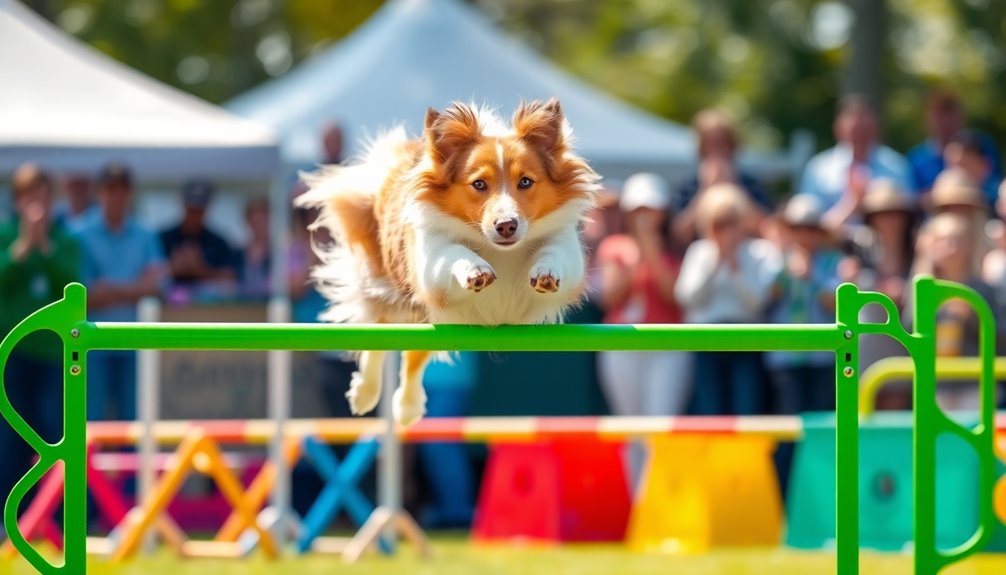
When you think of Shetland Sheepdogs, their exceptional herding instinct often comes to mind, but they also shine in agility competitions.
These dogs, known for their intelligence and quick reflexes, can navigate challenging courses with impressive speed and accuracy.
Plus, if you're a fan of the classics, you might remember them as the stars of the beloved 'Lassie' series, showcasing their extraordinary abilities.
Exceptional Herding Instinct
Often regarded as one of the most agile breeds, Shetland Sheepdogs showcase exceptional herding instincts that translate seamlessly into their agility skills. Bred in the Shetland Islands to herd sheep and livestock, these dogs possess a strong drive to work, fueled by their high energy levels.
You'll notice how quickly they respond to commands and movements, making them efficient herders capable of managing multiple animals at once. Their excellent eyesight allows them to monitor the movement of livestock effectively, while their small size enables them to navigate tight spaces effortlessly.
As you train your Sheltie, you'll find that their agility shines through; they can change direction and speed rapidly, excelling in various dog sports. Their lightweight build aids in performing complex jumps and maneuvers with grace.
Thanks to their intelligence and problem-solving instincts, Shetland Sheepdogs adapt well to new tasks. With consistent training and positive reinforcement, you can channel their herding instincts productively, whether in agility competitions or everyday activities. Regular check-ins during training sessions can encourage open communication and strengthen your bond with your Sheltie.
Ultimately, these remarkable dogs embody the perfect blend of agility and herding ability, showcasing why they excel in both realms.
Star of 'Lassie' Series
Renowned for their agility and intelligence, Shetland Sheepdogs shine in the world of dog sports, including agility competitions. While the iconic "Lassie" series featured a Rough Collie, it's important to recognize that Shelties possess their own unique skills. These small yet agile dogs are highly trainable and often excel in various dog activities, making them a favorite in agility trials. You might be inspired by Shelties like Bee, who won the overall agility championship at the 2022 Westminster Masters Agility Championship. Their natural agility and eagerness to please make them quick learners, thriving in environments that challenge their sharp minds and agile bodies. Although Lassie's breed is larger, both Rough Collies and Shetland Sheepdogs share intelligence and loyalty, as exemplified by their consistent placement in television history. Agility training for Shelties involves using household objects as props and participating in local classes. With patience and positive reinforcement techniques like treats and praise, you can help your Sheltie build confidence and enjoy the training process.
Active Lifestyle Compatibility
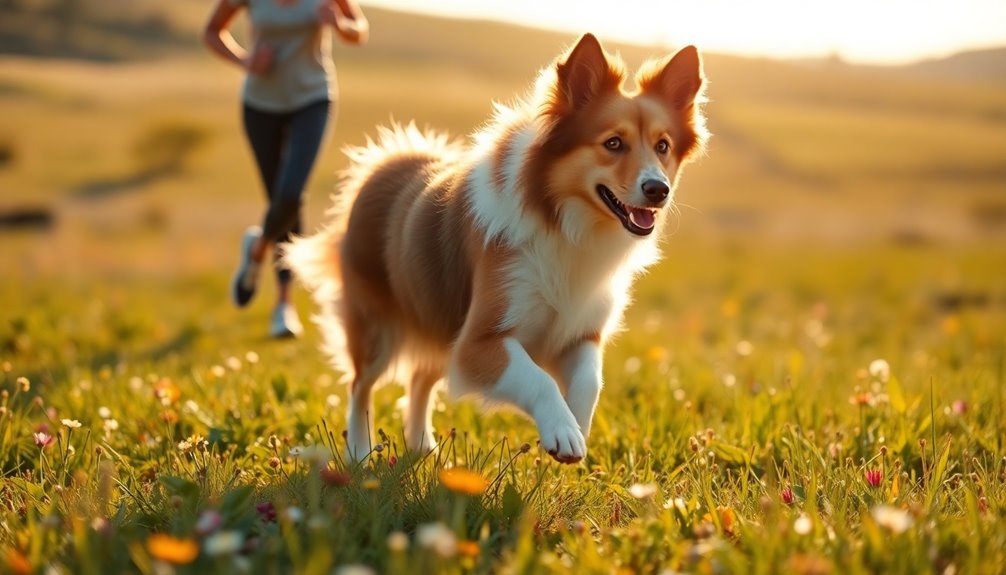
If you lead an active lifestyle, a Shetland Sheepdog could be the perfect companion for you and your family.
They thrive on physical exercise and mental challenges, so be prepared to commit time to training and engaging activities. Regular vet consultation is important to ensure proper dietary adjustments for their age and activity level, which helps maintain their energy and health.
This breed's energy and intelligence make them ideal for families that enjoy outdoor adventures and structured play.
Ideal for Active Families
For active families seeking a loyal companion, the Shetland Sheepdog shines with its high energy and playful nature. These dogs thrive on daily exercise, needing at least 60 minutes of activity to keep them happy and healthy. Regular exercise also supports joint health and mobility, which is essential for their overall well-being.
You can split this time into multiple sessions that include brisk walks, jogging, or agility training. Engaging in herding games and fetch not only satisfies their instinctual behaviors but also provides the mental challenges they crave.
Socializing your Sheltie through group walks or dog park visits can enhance their overall well-being and behavior. Interactive toys and puzzle games are great for keeping their minds sharp, preventing boredom, and avoiding destructive behaviors.
It's important to tailor exercise to your Sheltie's age, with puppies needing shorter play sessions while adults can handle more intense activities. Seniors will benefit from gentler exercises to maintain mobility.
Remember to adjust exercise routines based on weather conditions to ensure your dog stays comfortable. With proper care and attention to their activity needs, a Shetland Sheepdog can be the perfect fit for an active family, bringing joy, companionship, and a healthy lifestyle to your home.
Time Commitment for Training
Consistently dedicating time to training your Shetland Sheepdog is essential for their development and happiness. To keep your Sheltie engaged, aim for short training sessions lasting 10-15 minutes, especially with puppies. Frequent, bite-sized sessions are far more effective than lengthy ones.
Puppies can handle multiple short training sessions each day, while adult Shelties also thrive on this approach to maintain focus. Additionally, these dogs are known for their strong instinct to herd various animals, making training particularly rewarding.
In addition to training, Shelties need at least 30-60 minutes of outdoor exercise daily. You can break this into two or three shorter sessions that include walks, runs, or playtime. Activities like agility training and fetch not only keep them physically fit but also mentally stimulated, preventing boredom and destructive behaviors.
Mental stimulation is crucial, too. Incorporate puzzle toys and interactive games into their routine, as these challenge their intelligence and keep them engaged. Using positive reinforcement methods, like treats and praise, makes training enjoyable for both you and your Sheltie.
Ultimately, balancing training with physical exercise and mental challenges is key. Adapt your routines based on your dog's age, health, and energy levels for a well-adjusted, happy Shetland Sheepdog.
Frequently Asked Questions
How Do Shetland Sheepdogs Interact With Children and Other Pets?
Shetland Sheepdogs generally interact well with children and other pets. They're friendly and affectionate, making them great companions for kids.
Just ensure you supervise their interactions, especially with younger children, to maintain safety.
When introducing them to other pets, do it gradually to foster harmony.
Proper training and socialization are key to managing their herding instincts and ensuring they coexist peacefully with everyone in your household.
What Is the Average Cost of a Shetland Sheepdog?
The average cost of a Shetland Sheepdog ranges from $800 to $2,500, influenced by factors like breeder reputation, location, and pedigree.
If you're looking for a puppy with champion bloodlines or unique colors, you might pay up to $5,000.
Keep in mind that ongoing costs, such as food, healthcare, and grooming, can add up, so budgeting for these expenses is essential when considering your new furry friend.
Are Shetland Sheepdogs Prone to Any Specific Behavioral Issues?
Yes, Shetland Sheepdogs can exhibit specific behavioral issues due to their herding instincts.
You might notice them barking at cars or chasing joggers during walks. They can nip at heels, especially around children or smaller animals.
Their sensitivity makes them prone to anxiety if not properly trained, so positive reinforcement is essential.
Socialization is crucial, as they may be wary of strangers.
Addressing these behaviors early on can help them thrive.
How Can I Tell if My Shetland Sheepdog Is Happy?
To tell if your dog's happy, look for relaxed muscles and a balanced stance. A gently wagging tail and relaxed ears are good signs.
You'll notice playful behavior, eagerness to please, and a joyful demeanor. If they enjoy family activities and seek your attention, they're likely content.
Ensure they get plenty of exercise and mental stimulation, which helps maintain that happiness. Regular grooming and social interactions also contribute to their overall well-being.
What Are the Common Myths About Shetland Sheepdogs?
You might've heard some common myths about Shetland Sheepdogs.
Many think they're just miniature Collies, but they're distinct breeds with different traits.
Some believe Shelties are constant barkers, when in reality, they can be trained to bark less.
Others assume they need tons of exercise, but they actually thrive on moderate daily activity.
Lastly, while some worry about their behavior with kids or pets, Shelties can be gentle and affectionate with proper socialization.
Conclusion
In conclusion, Shetland Sheepdogs make fantastic companions for those who lead an active lifestyle. Their intelligence and agility shine in various activities, from herding to agility competitions. With the right training and socialization, these affectionate dogs thrive in loving homes, bringing joy and energy to your life. Whether you're hiking, running, or engaging in dog sports, a Shetland Sheepdog will keep you motivated and entertained every step of the way!

